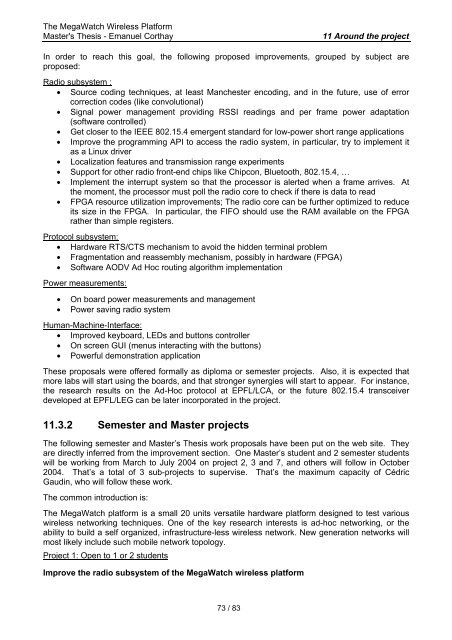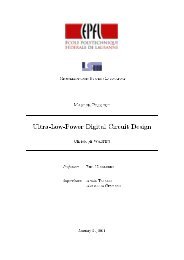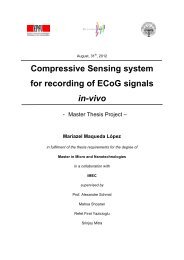Design and Realization of a Prototype Hardware Platform for ...
Design and Realization of a Prototype Hardware Platform for ...
Design and Realization of a Prototype Hardware Platform for ...
You also want an ePaper? Increase the reach of your titles
YUMPU automatically turns print PDFs into web optimized ePapers that Google loves.
The MegaWatch Wireless <strong>Plat<strong>for</strong>m</strong>Master's Thesis - Emanuel Corthay11 Around the projectIn order to reach this goal, the following proposed improvements, grouped by subject areproposed:Radio subsystem :• Source coding techniques, at least Manchester encoding, <strong>and</strong> in the future, use <strong>of</strong> errorcorrection codes (like convolutional)• Signal power management providing RSSI readings <strong>and</strong> per frame power adaptation(s<strong>of</strong>tware controlled)• Get closer to the IEEE 802.15.4 emergent st<strong>and</strong>ard <strong>for</strong> low-power short range applications• Improve the programming API to access the radio system, in particular, try to implement itas a Linux driver• Localization features <strong>and</strong> transmission range experiments• Support <strong>for</strong> other radio front-end chips like Chipcon, Bluetooth, 802.15.4, …• Implement the interrupt system so that the processor is alerted when a frame arrives. Atthe moment, the processor must poll the radio core to check if there is data to read• FPGA resource utilization improvements; The radio core can be further optimized to reduceits size in the FPGA. In particular, the FIFO should use the RAM available on the FPGArather than simple registers.Protocol subsystem:• <strong>Hardware</strong> RTS/CTS mechanism to avoid the hidden terminal problem• Fragmentation <strong>and</strong> reassembly mechanism, possibly in hardware (FPGA)• S<strong>of</strong>tware AODV Ad Hoc routing algorithm implementationPower measurements:• On board power measurements <strong>and</strong> management• Power saving radio systemHuman-Machine-Interface:• Improved keyboard, LEDs <strong>and</strong> buttons controller• On screen GUI (menus interacting with the buttons)• Powerful demonstration applicationThese proposals were <strong>of</strong>fered <strong>for</strong>mally as diploma or semester projects. Also, it is expected thatmore labs will start using the boards, <strong>and</strong> that stronger synergies will start to appear. For instance,the research results on the Ad-Hoc protocol at EPFL/LCA, or the future 802.15.4 transceiverdeveloped at EPFL/LEG can be later incorporated in the project.11.3.2 Semester <strong>and</strong> Master projectsThe following semester <strong>and</strong> Master’s Thesis work proposals have been put on the web site. Theyare directly inferred from the improvement section. One Master’s student <strong>and</strong> 2 semester studentswill be working from March to July 2004 on project 2, 3 <strong>and</strong> 7, <strong>and</strong> others will follow in October2004. That’s a total <strong>of</strong> 3 sub-projects to supervise. That’s the maximum capacity <strong>of</strong> CédricGaudin, who will follow these work.The common introduction is:The MegaWatch plat<strong>for</strong>m is a small 20 units versatile hardware plat<strong>for</strong>m designed to test variouswireless networking techniques. One <strong>of</strong> the key research interests is ad-hoc networking, or theability to build a self organized, infrastructure-less wireless network. New generation networks willmost likely include such mobile network topology.Project 1: Open to 1 or 2 studentsImprove the radio subsystem <strong>of</strong> the MegaWatch wireless plat<strong>for</strong>m73 / 83















